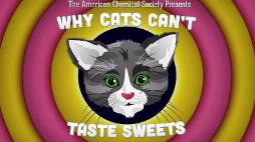FOR IMMEDIATE RELEASE | March 04, 2013
New American Chemical Society video explains why cats lack a sweet tooth
WASHINGTON, March 4, 2013 — Do cats purrr-ferrr sardines or sweets? The American Chemical Society (ACS), the world’s largest scientific society, today released a new Bytesize Science video that explains why cats, unlike humans and other mammals, are indifferent to sweet flavors. Produced by the ACS Office of Public Affairs, it is available at www.BytesizeScience.com.
The video was filmed at the Monell Chemical Senses Center, an institute dedicated to research on taste and smell. Prior to becoming Monell’s Director, Gary Beauchamp, Ph.D., studied the sweet taste receptor genes of cats in the late 1970s. At the Philadelphia Zoo, he gave lions, tigers, cheetahs and housecats two different types of water — sugar water and regular water. The cats showed no preference to the sugar water, suggesting a physiological difference between other mammals, such as humans, monkeys and dogs.
Media Contact
Michael Bernstein
202-872-6042
m_bernstein@acs.org
Michael Woods
202-872-6293
m_woods@acs.org
The video explains how scientists from the Monell Chemical Senses Center later uncovered the cause behind the cat’s missing sweet tooth. In place of a functional sweet taste receptor gene, they discovered that cats have a pseudogene, or a broken gene, that makes them unable to detect sweet tastes.
For more entertaining, informative science videos and podcasts from the ACS Office of Public Affairs, view Prized Science, Spellbound, Science Elements and Global Challenges/Chemistry Solutions.
To automatically receive news releases from the American Chemical Society contact newsroom@acs.org.
###


